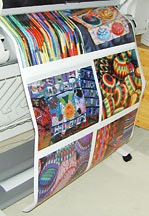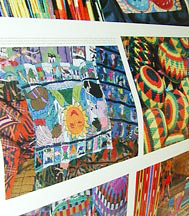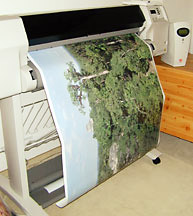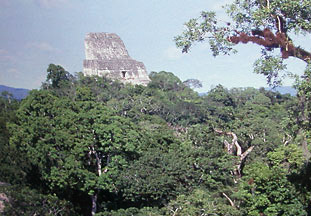If your museum has its own large format printer then you can create all kinds of useful signs, posters, and banners.
 |
Large format color inkjet printer prices are low enough so that museums, botanical gardens, zoos, and even departments within universities and colleges can afford to have their own wide format printer in-house.
Shown here are prints from a Hewlett-Packard DesignJet 2800CP large format inkjet color printer. This prints on photo paper 36 inchs wide (the model 3800 prints on paper 54 inches wide). In the prints shown here (indigenous Maya textiles photographed in Guatemala) each rectangular image is about 17.5 inches across. The printer prints continously, as long as you need (the paper is 100-feet long, on a seamless100 foot long roll).
These printers are easy to operate, indeed this printer is in my own office (F.L.A.A.R. Photo Archive). This printer is part of the long range digital imaging technology program, initiated 3 years ago by a fellowship from Japan's Ministry of Education. This Visiting Professorship took Dr Hellmuth to Japan's National Museum of Ethnology in Osaka, for training in digital imaging. Dr Yoshiho Yasugi, curator at Minpaku, is a Japanese expert in Mayan languages, hieroglyphs, and Mayan weaving.
 |
One of the many goals of this program is to ascertain what is the best yet most reasonably priced digital imaging equipment for schools, colleges, universities and museums. Since the Japanese economy took a nose dive over the last two years, there is no longer Japanese funding for this useful program, but F.L.A.A.R. still works hard and seeks support from the computer industry.
If you would like more information on what equipment your institution should include in its current budget, look at www.wide-format-printers.org, www.large-format-printers.org, and www.FineArtGicleePrinters.org. These sites picture and explain the various items of digital equipment, such as a RIP, pictured here. The RIP is the brain, the raster image processor, of the overall wide format printer system.
If you have ever seen the old plotters that architects and engineers used several years ago then you have an idea what a large format printer looks like. Today's inkjet printers are to some degree the descendant of those CAD plotters. Today, however, the large format printers are no longer called plotters, in part because they are much faster and produce photo-realistic exhibit-quality images.
  |
New page format posted July 31, 2009
this page first posted April 2, 2000